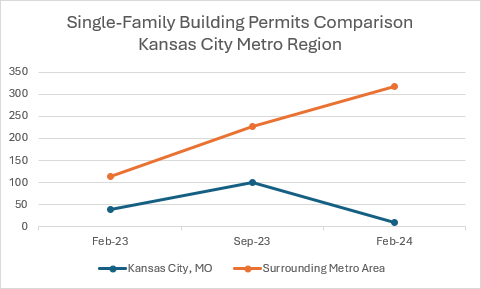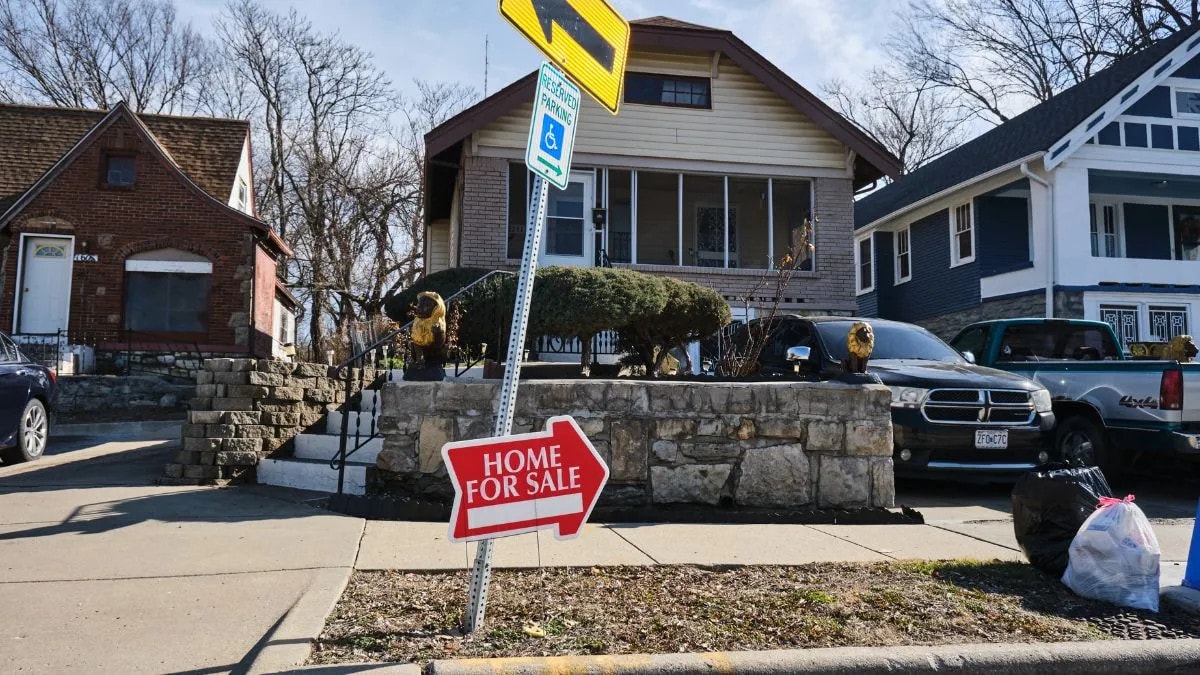Kansas City Homeowners Don’t Want to Sell. Here’s Why Higher Mortgage Rates and Tight Supply Make it Harder to Move
Published April 10th, 2024 at 10:56 AM
Above image credit: The Aspen Homes team is building a new property. New home construction struggles to keep pace with housing demand in Kansas City. (Mili Mansaray/The Beacon)If you’re looking to buy a home in Kansas City in today’s market, brace for scarcity and tough competition.
Real estate experts say that people who already own their homes, locked in with historically low mortgage rates, appear reluctant to sell and take on higher interest rates that would come with the purchase of a house in today’s mortgage market.
Seattle-based real estate brokerage Redfin found that 433 homes were sold in the Kansas City limits in February, a 13% drop from the same period last year.
Meanwhile, home construction is surging. The Heartland Multiple Listing Service shows that 638 residential building permits were issued across the Kansas City area in the first two months of 2024, nearly double the start of last year.
But homebuilders say rising labor and materials cost make it hard to keep up with demand due to heightened building costs, ultimately pushing affordability out of reach for many first-time homebuyers.
“New housing supply is increasingly difficult to deliver,” said Will Ruder, executive vice president of the Home Builders Association of Greater Kansas City.”
What’s Contributing to Kansas City’s Housing Shortage?
In February, Redfin reported, the median sale price of a home in Kansas City reached $250,000, marking an 11% increase from last year.
Data show, predictably, that a shortage of existing houses (as opposed to newly built homes) on the market is driving up prices. According to U.S. Bank, 2023 saw the slowest year for existing home sales nationwide since 1995.
The trend of large corporate investors purchasing swaths of single-family residences to convert into rentals intensifies competition among buyers. Housing experts say that the reluctance of homeowners to sell tightens the market more and ramps prices even higher.
The economic uncertainty brought on by the pandemic caused the Federal Reserve to lower its federal funds rate to stimulate borrowing and lending. That led to record-low interest rates of 2% and 3% for homebuyers or refinancers, Ruder with the Home Builders Association said.
But by 2022, rates shot up to about 7.1%, their highest level in 20 years. Now, interest rates hover around 6%.
A Goldman Sachs report found that nearly three in four existing homes have mortgages at or below 4%. Reluctance to sell and take on higher mortgages is keeping homeowners in place. It’s called the “lock-in effect.”
“People are scared to sell their houses because they don’t have anywhere to go,” said Patty Farr, the owner of real estate brokerage RE/MAX House of Dreams. “They’re sitting in a house at 2.5% interest rates and if they buy a new house it’s gonna cost them anywhere from 6% to 8%.”
She doesn’t foresee rates going down drastically soon, so she tells her young homebuyers to purchase a house and refinance later.
But homeowners need to be willing to take on a larger financial burden — and to gamble that rates will fall quickly enough to align with their budgets.
Homebuyers and Sellers are Stuck
Maret Cissner owns two units within a four-plex cooperative and lives in one. She purchased her property in 2016 and she has spent the past year in search of a bigger space to be able to work from home.
But she’s a pianist and visual artist. And getting a loan is tough because banks don’t look at freelance income the same as a salary.
“They won’t look at any W-2 income that hasn’t been at least two years,” she said.
Cissner makes about $50,000 and her mortgage is $400 a month with a 4.5% interest rate. But the artist wouldn’t mind paying more for a better quality of life.
“I’m less interested in building my wealth and more interested in our living situation,” she said.
February saw an uptick in existing home sales, data from the Heartland Multiple Listing Service found. But Ruder said that the winter months are typically slow. The selling season happens in the spring because families prefer to move between school years. Still, the early part of the year at least hints at a shift.
“As more people get comfortable with the fact that these interest rates are probably not gonna go back down to those historic lows,” he said, “then we’ll see more home-buying.”
Is New Home Construction the Answer to Kansas City’s Housing Shortage?
Newly constructed homes are almost always more expensive than resale homes. And builders say they are more expensive to produce than they have been in the past.
Some empty lots in the Kansas City market run north of $100,000, Ruder said.
“And so if you’re in $100,000 just for the dirt, it’s increasingly difficult, if not impossible … to build something on there and to hit a price point under $350,000,” he said.
Farr with RE/MAX said the homes it sells typically cost $450,000.
Houses sold by Aspen Homes begin at $500,000, said Tony Libra, owner of the residential construction company.
Libra said rising labor and material costs keep pushing prices up.
“Concrete is really going up right now,” he said. “Lumber is going to go up this summer, too.”
Builders say navigating construction rules that vary from one city to the next make it hard to meet demand. Missouri is one of a handful of states without a statewide building code.
Ruder said Kansas City operates on a separate adoption cycle for residential building codes compared to surrounding suburbs.
He cited the 2021 International Energy Conservation Code for home building as an example.
The Kansas City Council approved that code in 2022, raising efficiency standards for new construction. Those IECC rules took effect in July 2023. But surrounding cities are on a 2018 energy code and are set to adopt a new one in 2024, Ruder said.
By September 2023, Kansas City saw a dramatic dip in building permits. Excluding Kansas City, the metro saw a 117% rise in single-family construction permits in January and February compared to the same time last year, MLS data show. Kansas City saw a 22% decrease in that same period.
Ruder says a dip in builds and permitting is expected after building codes change, but that typically resolves within six months. But in over a year, Kansas City has yet to recover.

Builders also say that the new code increases construction costs. Before, a housing plan could be duplicated so long as the original model received a permit. But the IECC’s focus on site-specific energy efficiency means a plan would need adjustments based on a lot’s orientation.
“It’s very labor intensive to satisfy all of those requirements and build at the volume that the market is calling for,” Ruder said.
Researchers with the U.S. Department of Energy have found the 2021 IECC codes to be cost-effective for families and state governments. A 2021 report states that it is significantly more expensive to achieve higher efficiency levels through later modifications once a building is constructed.
Builders sing a different tune.
They say depending on how far above code a construction company is already building, meeting a new metric can come with a wide range of construction costs. The Home Builders Association of Greater Kansas City found that it could cost anywhere between $8,000 and $30,000 to build exactly to IECC standards.
The code adds $35,000 to the price of a property at Aspen Homes, Libra said.
This article first appeared on The Beacon and is republished here under a Creative Commons license. Mili Mansaray is the housing and labor reporter with The Beacon, a member of the KC Media Collective.




